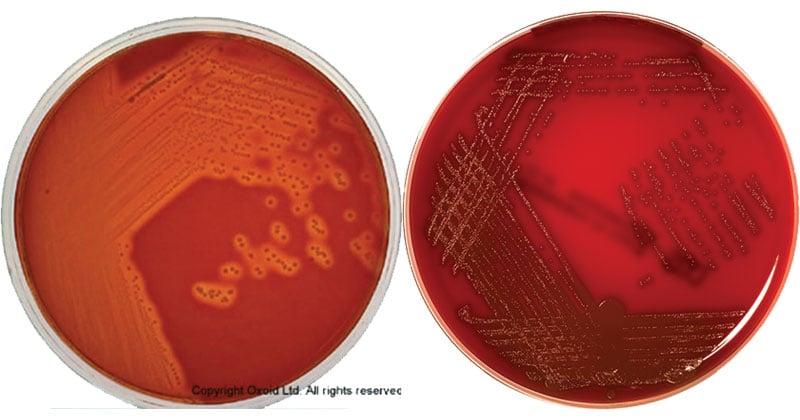Columbia Agar with 5% Sheep blood is a highly nutritious general-purpose medium for the isolation and cultivation of the non-fastidious and fastidious microorganisms from various clinical specimens and non-clinical specimens of public health importance. Columbia Blood Agar was first described in 1966 by Ellner et al who incorporated animal-derived peptone, enzymatic digests of casein, and enriched medium by addition of the defibrinated sheep blood into one medium. It was found to be an improved blood agar, promoting both luxuriant and rapid growth, improved pigment production, typical colony morphology, and sharply defined hemolytic reactions.

Interesting Science Videos
Composition of Columbia Agar with 5% Sheep Blood
| Pancreatic Digest of Casein | 12.0 g |
| Peptic Digest of Animal Tissue | 5.0 g |
| Yeast Extract | 3.0 g |
| Beef Extract | 3.0 g |
| Corn Starch | 1.0 g |
| Sodium Chloride | 5.0 g |
| Agar | 13.5 g |
| Sheep Blood, Defibrinated | 5 % (50ml) |
pH 7.3 ± 0.2 at 25°C
Principle of Columbia Agar with 5% Sheep Blood
The medium contains peptones that supply nitrogen, carbon, vitamins, and trace elements necessary for the growth of the bacterium. Yeast extract act as the supplier of the vitamin B complex. Corn starch serves as the energy source for organisms and also neutralizes toxic metabolites by absorbing toxic by-products contained in the specimen. Sodium chloride is a source of essential electrolytes and maintains osmotic equilibrium. Sheep blood is added to demonstrate hemolytic reactions and supplies the X factor (heme) necessary for the growth of many pathogenic species. On this medium, colonies tend to be larger and growth is more luxuriant than on media containing other blood agar bases.
Preparation of Columbia Agar with 5% Sheep Blood
Preparation of Columbia Agar Base
- Add components to distilled/ deionized water and bring volume to 1.0L.
- Mix thoroughly.
- Gently heat until boiling.
- Autoclave for 15 min at 15 psi pressure–121°C.
- Cool to 45°–50°C.
Preparation of Columbia Agar with 5% Sheep Blood
- To 950.0mL of cooled, sterile Columbia agar base, aseptically add 50.0mL of sterile, defibrinated sheep blood.
- Mix thoroughly.
- Pour into sterile Petri dishes or distribute into sterile tubes.
Results Interpretation of Columbia Agar with 5% Sheep Blood
| Organisms | Colony characteristics |
| Streptococci (non-group D) | Small, white to grayish. Beta or alpha hemolysis |
| Enterococci (Group D) | Small, but larger than group A streptococci, grayish. Alpha (rarely beta) hemolysis |
| Staphylococci | Large, white to gray or cream to yellow, with or without hemolysis |
| Corynebacteria | Small to large, white to gray or yellow, with or without hemolysis |
| Listeria monocytogenes | Small to medium-sized, grayish, with weak beta hemolysis |
| Enterobacteriaceae | Medium-sized to large, grey colonies, with or without hemolysis |
| Candida species | Small, white colonies |
Uses of Columbia Agar with 5% Sheep Blood
- Columbia Blood Agar is recommended as a frequently used primary isolation medium for isolation of non-fastidious and fastidious microorganisms from clinical specimens.
- It is a primary isolation medium on which most microorganisms, such as Enterobacteriaceae, Pseudomonas, and other non-fermenting Gram-negative rods, streptococci, enterococci, staphylococci, coryneforms, Candida species, and many others will grow.
Limitations of Columbia Agar with 5% Sheep Blood
- It is recommended that biochemical, immunological, molecular and mass spectrometry testing be performed on colonies from pure culture for complete identification.
- The medium lacks V factor (nicotinamide adenine dinucleotide, NAD) since sheep blood contains NADase which destroys the NAD. Hence, Haemophilus influenzae which requires both the X and V factors, will not grow on this medium.
- Neisseria gonorrhoeae does not grow well on this medium.
- The medium is not suitable for the isolation and growth of Mycobacterium, Legionella, Bordetella and other organisms with highly specific nutritive requirements.
- Due to the rather high carbohydrate (starch) content in the Columbia Agar Base, beta-hemolytic streptococci may exhibit alpha rather than beta hemolytic reactions or may exhibit weak hemolytic reactions on media based on this formulation.
References
- Ronald M. Atlas and James W. Snyder (2014). Handbook of media for clinical and public health microbiology. CRC Press. Taylor & Francis Group, LLC. Page no.148-149.
- Becton Dickinson
- Himedia
- Hardy Diagnostics
- Thermo Fisher
